A Restatement: The Art of ‘Ground Zero’ (Part 32)
The Endless International Exhibition: ‘Don’t Follow the Wind’ Update (III)
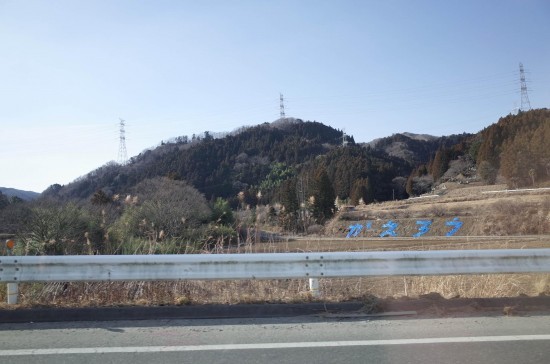 Okumamachi, Futaba-gun, Fukushima, January 2017. Photo: Shuji Akagi, © Shuji Akagi︎.
Okumamachi, Futaba-gun, Fukushima, January 2017. Photo: Shuji Akagi, © Shuji Akagi︎. Between midnight of March 31 and midnight of April 1 this year, the evacuation orders issued for the Hamadori region and other areas of Fukushima Prefecture (restricted residence zone and the zone in preparation for the lifting of the evacuation order) due to contamination by radioactive material following the accident at the Fukushima Daiichi Nuclear Power Plant were lifted for almost the entire area, excluding the difficult-to-return zone. The difficult-to-return zone is also the area across which the “Don’t Follow the Wind” venues are scattered. Today, more than six years after the accident, this “exhibition that no one can see” remains an exhibition that no one can visit.
What was surprising was that the orders for the restricted residence zone and the zone in preparation for the lifting of the evacuation order were lifted at more or less the same time. In fact, even before the evacuation orders were lifted, things had reached the stage where anyone could have visited these two zones if they really wanted to; though evacuation orders had been issued, there were no barricades or any other physical enclosure. In both of these zones, it was theoretically impossible to stay overnight, though in the latter people had been permitted to resume their work activities during the day. There were other differences between the two zones, but I will refrain from going into the finer details. However, that the progress of the decontamination work and development of infrastructure was more advanced in the zone in preparation for the lifting of the evacuation order than in the restricted residence zone in the lead up to the lifting of the evacuation orders is probably clear from the former’s name. Which is why I thought the evacuation orders would be lifted one area at a time, with the evacuation order in the zone in preparation for the lifting of the evacuation order being lifted as soon as the “preparations” were complete, at which point the status of the restricted residence zone would be “upgraded” to that of a zone in preparation for the lifting of the evacuation order. In fact, however, this was not how things proceeded.
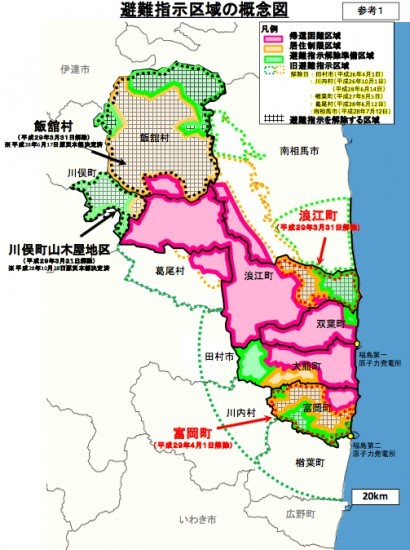 Conceptual diagram of areas under evacuation orders, released March 10, 2017 (from the Ministry of Economy, Trade and Industry website). The status of the hatched areas was revised this spring.︎
Conceptual diagram of areas under evacuation orders, released March 10, 2017 (from the Ministry of Economy, Trade and Industry website). The status of the hatched areas was revised this spring.︎Probably this was because the “preparations” in the lead up to the lifting of the orders in the restricted residence zone and the zone in preparation for the lifting of the evacuation order were in fact proceeding more or less in parallel (or had caught up with each other) in all the affected areas, and it was no longer necessary to take the differences into consideration. In other words, at some point the differences between the two had in effect disappeared. Of course, this does not affect the status of the difficult-to-return zone, but this zone was differentiated from the restricted residence zone and the zone in preparation for the lifting of the evacuation order from the outset and there is no difference to the fact that all three were originally part of the same “evacuation order zone.” With the disappearance this spring of the greater parts of the restricted residence zone and the zone in preparation for the lifting of the evacuation order, in effect the difficult-to-return zone is now more or less the same as the evacuation order zone. Nevertheless, the government has not gone as far as changing the name of the difficult-to-return zone. The difficult-to-return zone and the evacuation order zone are not yet completely the same. So what are the differences?
What I am talking about is not necessarily limited to regulatory issues. I have always thought that reintroducing into the Japanese language the term “difficult-to-return zone,” which no one had heard of until the nuclear accident, not as a meaningless term for administrative purposes but as a critical concept was one of the jobs of critics, whose work involves dealing with language. So, exactly what kind of place is a “difficult-to-return zone”? According to the Ministry of Economy, Trade and Industry, it is “an area where the annual cumulative radiation dose estimated from the air dose rate may not fall below 20 millisieverts even six years after the nuclear accident. An area where the annual cumulative radiation dose estimated from the air dose rates exceeds 50 millisieverts as of March 2012.” (1) At the same time, according to Fukushima Revitalization Station (the official revitalization information website run by Fukushima Prefecture), it is “a zone where, because the amount of radiation is extremely high, barricades and other protective measures are implemented and people are required to evacuate,” which is a slightly different way of putting it. (2) In the former, the amount of radioactive contamination is indicated in actual figures, while in the latter it is not indicated, and if anything the fact that the entire zone is closed off with barricades and people are officially required to evacuate is emphasized. The important thing here is probably not which of the two is correct, but that now, when the entirety of the areas affected by evacuation orders are more or less equivalent to the difficult-to-return zone, the latter seems to most clearly express the distinguishing features of this zone: it is a place that is closed off with barricades and not easy to enter due to the effects of radioactive contamination.
However, while it is not easy to enter, it is not impossible to do so as long as one follows legitimate procedures. Upon application, those who have (or had) houses or places of business inside the difficult-to-return zone – though the length of each visit is limited – may return to their houses or places of business temporarily. And in fact such opportunities are being used to deal with damage caused by wild boar and rats, to put houses in order and to visit graves during Obon to hold memorial services. As for Grand Guignol Mirai, none of us had houses or places of business inside the zone before the accident. However, because we have obtained permission separately to carry out non profit-making activities, whenever we need to enter the zone to document the exhibits, maintain the artworks or carry out performances without an audience, we make an application to the local municipality and upon presenting a permit along with our passports or other ID at a checkpoint we are allowed to pass through the barricades and into the zone.
Some people may be surprised by this, but inside the difficult-to-return zone, because decontamination work and preparations for the development of infrastructure are being carried out continually, the main roads are constantly busy with trucks carrying decontaminated soil and so on, and various other kinds of work are always in progress, so it is not as if there are no signs of life whatsoever. In this sense, the impression one gets is rarely anything like the “ghost town” so often talked about. Rather, with the cries of wild birds filling the air on days when the sky is clear and blue the impression is even tranquil. Certainly, because no one is living in them, the individual houses appear deserted, and it is strange to see the entrances facing the street barricaded, but simply looking at a single photograph it would be difficult to clearly tell the difference between this zone and a desolated town on a quiet holiday. As well, while at one time scenes of farmland containing piles of flexible container bags of decontaminated soil were widely reported, most of these have now disappeared and the majority of the fields are now empty again. Weeds have been cut back and the scenes of goldenrod growing out of control as if it owned the place are more or less a thing of the past. The roads, too, have been newly surfaced and improved and radiation levels have fallen far below initial readings.
However, this does not alter the fact that the difficult-to-return zone remains a place to which people cannot “return” due to radioactive contamination. One often sees the difficult-to-return zone described as the difficult-to-go-home zone. But this is a misleading expression because people are able to go home temporarily. What, then, is the difference between “returning” and “going home”?
Let us look at it from a slightly different angle. In considering what kind of place the difficult-to-return zone is, or in thinking about “the difference between returning and going home,” it may help not to be overly concerned with the “evacuation orders” but instead to compare this zone with other places in the country such as the US military bases concentrated on Okinawa and the former public leprosy sanatoriums where people who suffered from leprosy were once unjustly quarantined. What these places all have in common is the fact that people are or were unable to return their “hometowns” as a result of state policy. For example, both the difficult-to-return zone and the US military bases on Okinawa are physically closed off with barricades or fences and entry to them is severely restricted, so that even the people who once had homes there cannot easily go inside. Similarly, once people were put inside leprosy sanatoriums it was extremely difficult for them to go home. In many cases, even after they died and were cremated they were unable to return to their hometowns to be buried – because quarantine and eradication and also sterilization were state policies. It was not as if these people were detained after committing some kind of crime. So it was not imprisonment for the purposes of punishment. Furthermore, despite the facts that leprosy is not highly contagious, that effective medication had existed for some time and that it was easy to cure, the exit of people from these facilities was strictly controlled. For people who once suffered from leprosy, the difficult-to-return zone included not only their “hometowns” but the entire area “outside” their facility.
Today, when we refer to evacuation order zones arising from the nuclear accident and US military bases as “difficult-to-return zones,” they are none other than places that have special meaning. In reality, we cannot live in evacuation order zones arising from the nuclear accident or US military bases. However, because for people confined to former nursing homes for leprosy patients the difficult-to-return zone extends outside their facility, or in other words to everywhere except their facility, for those of us who live outside to begin with it lacks such a harsh nature. On the contrary, because it is the people who were once patients who had this harsh nature inflicted on them by the state, what was for us our everyday life became for them a difficult-to-return zone. In other words, the here and now in which we live was for them the difficult-to-return zone. Or perhaps in a continuation of the injustice they have experienced it remains the case even now.
In this regard, former leprosy sanatoriums are very different from the evacuation order zones arising from the nuclear accident and US military bases, in which the places to which return is not possible have strong meaning and are identified. In the latter two cases, the hometowns of the people who once lived there remain difficult-to-return zones for all citizens. In the case of the former leprosy sanatoriums, however, the difficult-to-return zones for the people who were placed in them are places that under normal conditions anyone who is a Japanese citizen can visit.
In this way, perhaps the places that came to be identified using the new term “difficult-to-return zone” in the wake of the serious accident at TEPCO’s Fukushima Daiichi Nuclear Power Plant have continued to exist in various different forms from the past. It could be that as part of a process of forgetting and repetition, these places have repeatedly surfaced and sunk outside of history while changing their form. Perhaps they represent not a system but a subspecies of concept of the kind referred to by Deleuze. No doubt this is also the biggest difference compared to when these places are called simply “evacuation order zones.”
It was to such a place that I invited the film director Nobuhiko Obayashi. There, because history is null and void, like in The Girl Who Conquered Time, time is wound back to the same extent that it progresses on the outside, or like in Seven Weeks (2014), all the clocks have stopped at the time of the Tohoku earthquake and tsunami, 2:46 pm, or like in Exchange Students, the inside and outside of one’s hometown have switched places.
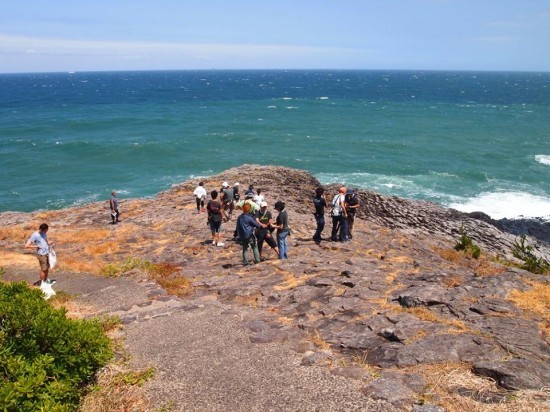
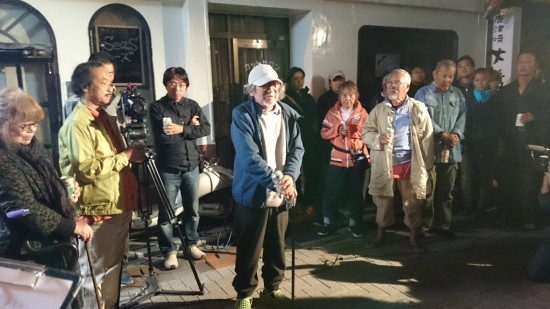 Above: Filming Hanagatami (The flower basket). Below: Nobuhiko Obayashi on the film set. Both: 2016. Images courtesy PSC/ Nobuhiko Obayashi Office.
Above: Filming Hanagatami (The flower basket). Below: Nobuhiko Obayashi on the film set. Both: 2016. Images courtesy PSC/ Nobuhiko Obayashi Office. In the end, however, this peculiar kind of time travel did not come to fruition, because as preparations were underway, it was revealed that Obayashi had stage 4 lung cancer. I hasten to add that, fortunately, treatment with the latest cancer therapy in the form of molecularly targeted agents seems to have been effective, and Obayashi has achieved such a miraculous recovery he now jokes that his life expectancy is “not fixed.” Moreover, his latest film, Hanagatami (The flower basket), is finished and awaiting its release this summer. And apparently he has already begun planning his next film. Which is good news indeed. Incidentally, the novel by Kazuo Dan on which Hanagatami is based, which was written the year before Dan was sent to mainland China to fight in the Sino-Japanese War, was in fact going to be the basis of what was meant to have been Obayashi’s first film for Toho, and an initial screenplay had even been prepared. However, for several reasons including Kazuo Dan’s death in 1976 and Toho’s aversion to a serious literary film, the project was shelved and hastily replaced with House (1977). In other words, for Obayashi, the movie Hanagatami is itself an example of “time travel” in which the illusive first work he conceived 40 years earlier has been brought back to life as his latest work in the 21st century. However, it was not the simple. The setting of the original novel, Kyushu (Karatsu, Saga, in the movie), was also the place where Dan passed away from lung cancer. Had Obayashi’s first work brought back to life in Kyushu after 40 years become a posthumous work, and had his life in movies gone full circle with his death from the same lung cancer as the author of the original work, it could only have been described as too good to be true. But in their continual departure from preestablished harmony, Obayashi’s films have always deviated from easy-to-understand histories. This time, too, the circle as a safe narrative has been splendidly broken.
On the other hand, the time travel concerning the difficult-to-return zone that Obayashi and I had planned at the start of this year never came to pass. Instead, I was able to get Obayashi to give me a message to take into the difficult-to-return zone. To be precise, I was able to newly add a message from Obayashi to Grand Guignol Mirai’s “Demio Fukushima 501,” one of the exhibits in the “Don’t Follow the Wind” exhibition that “everyone will be able to see” for the first time when the difficult-to-return zone is lifted. What I asked for is a message concerning the movie Manuke sensei (Doctor Blockhead) (2000). The movie’s protagonist, “Doctor Blockhead,” also appears in Obayashi’s first movie shot on film as a hand-drawn animated character who reminisces about his childhood in Onomichi, the starting point for Obayashi’s “hometown movies,” and his first encounter with movies. Doctor Blockhead also travels across time to appear frequently throughout the movie as “a person waiting for time” that has been buried as treasure underneath Tank Rock in Onomichi and will some day be unearthed. The first film director Obayashi met as a youngster at the place where this Tank Rock is located also took up a post in Hiroshima – which later became ground zero when the A-bomb was dropped – for the purposes of recording documentary footage. As a result, he was probably one of the many people who were exposed to radiation upon entering the city after the bombing itself.
Soon after Obayashi’s grand compilation of his movie experiences, Itsuka mita eigakan (Theater of movies I once saw) (Nanatsumori Shokan, 2016), was published, I was able to get him to write on the flyleaves of both volumes, as well as on the cover of the accompanying DVD, his current thoughts on “Doctor Blockhead” along with a message to the people viewing it in the “future” that has yet to arrive but will inevitably do so (the photos below show just the first of a number of drawings and texts).
And at this very moment, in the same way that the ground underneath Tank Rock waited to be dug up in the movie Manuke sensei, Doctor Blockhead, who was born in Obayashi’s hometown of Onomichi, and his words wait in the middle of the difficult-to-return zone where people are still prevented from returning to their hometowns for someone to analyze them via the “Don’t Follow the Wind” exhibition that has started but whose opening dates remain uncertain.
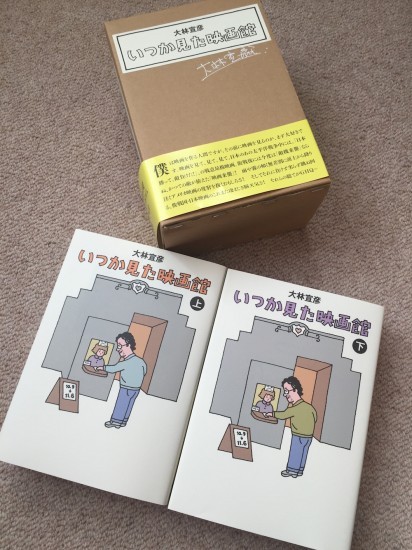
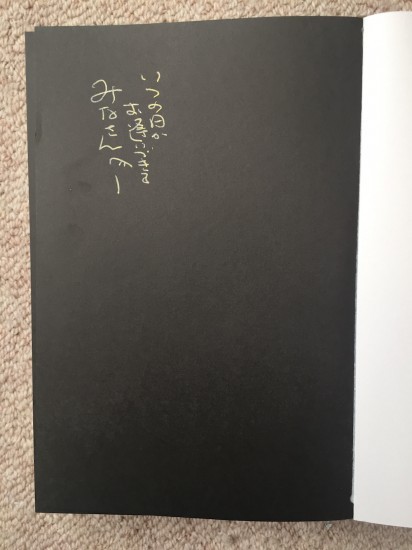
Written as if spoken by Doctor Blockhead himself, these messages will no doubt change in appearance little by little “over time” from “the theater of movies I once saw” to “the theater of movies I will one day see.” And ultimately they will undoubtedly be seen by the public. However, as to when that will be, at the present time when the difficult-to-return zone remains the “difficult-to-return zone,” no one knows.
-
- Reconstruction Agency website, “Reconstruction and Recover of Fukushima: Status of Areas under Evacuation Orders.” http://www.reconstruction.go.jp/english/topics/RR/index.html.
- Fukushima Revitalization Station,. “Translition of evacuation instruction zones.”
